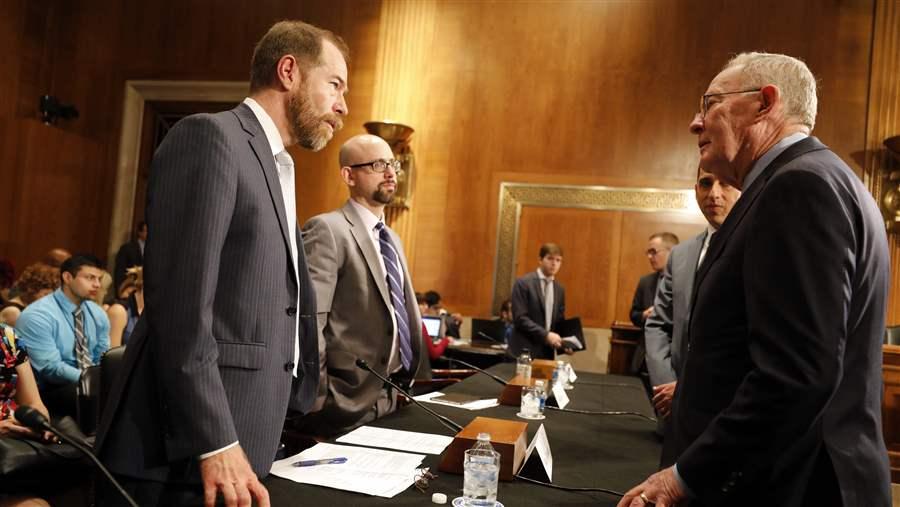The Latest on Drug Spending: Arkansas Regulates Pharmacy Benefit Managers
A roundup of recent research and policy news

Allan Coukell (left), Pew’s senior director of health programs, speaks with Senator Lamar Alexander (R-TN), chairman of the Health, Education, Labor, and Pensions Committee, at a 2017 hearing.
The Pew Charitable TrustsRising drug costs remain top of mind for policymakers and payers, who continue to consider ideas to rein in spending at the state and national levels. From efforts intended to reduce out-of-pocket costs for patients to pending policy proposals from the Trump administration, here are some recent developments on this issue.
More oversight of pharmacy benefit managers (PBMs)
Governor Asa Hutchinson (R) signed legislation that makes Arkansas the first state to regulate PBMs, the third-party administrators of prescription drug benefits for insurance companies. The law requires that PBMs be licensed by the state and gives the insurance commissioner authority to oversee their business practices, including the rates at which they reimburse pharmacies. It also bans “gag clauses” in contracts between PBMs and pharmacists that can prevent pharmacists from discussing the total price of a drug or cheaper alternatives with patients.
New federal initiatives intended to reduce prices
Secretary of Health and Human Services Alex Azar announced that the administration is “going to be rolling out … a whole slate of other proposals around how we decrease the price of drugs and how we bring discounts that the middlemen right now are getting; how those will go to our patients, to individuals.” The administration has already proposed requiring that Medicare Part D plans use some of the rebates they and PBMs negotiate with pharmaceutical manufacturers to reduce beneficiary cost sharing. However, the Centers for Medicare & Medicaid Services has said such a policy would drive up premiums and increase federal spending.
Savings at the pharmacy counter for some patients
Aetna announced that it would start passing along rebates next year from drug manufacturers to patients to reduce out-of-pocket costs in some of its plans. This change—unveiled shortly after UnitedHealthcare made a similar announcement—could lower out-of-pocket costs for an estimated 3 million patients out of the roughly 23 million people covered by Aetna medical plans. Savings from rebates are typically used to lower plan premiums, but allocating them instead to reduce patient out-of-pocket costs is likely to increase premiums.
Debate on the national drug discount program
The U.S. Senate Committee on Health Education, Labor, and Pensions held a hearing on the 340B Drug Pricing Program, which allows certain hospitals and other health care providers to obtain discounted prices on outpatient drugs from drug manufacturers. In addition to other issues, the panel discussed the size of the program in relation to overall drug spending. “Is it $6 billion or $8 billion or $14 billion?” Committee Chairman Lamar Alexander (R-TN) asked, referring to savings through the program. “If it’s 1 or 2 percent [of total drug spending], well that’s just a tax on pharmaceutical companies that we’re spending for a good purpose. But if it’s 6 percent to 8 percent, then that’s a pretty big tax. I’d like to get those figures.”
Penalties for drug manufacturers
MACPAC, the Medicaid and CHIP Payment and Access Commission, recommended that Congress give the secretary of health and human services authority to impose financial penalties on drug manufacturers that fail to submit accurate drug classification data. Such data are used to determine the level of rebates that manufacturers must pay the government under the Medicaid drug rebate program. The threat of financial penalties could encourage manufacturer compliance.
Ian Reynolds manages The Pew Charitable Trusts’ drug spending research initiative.






